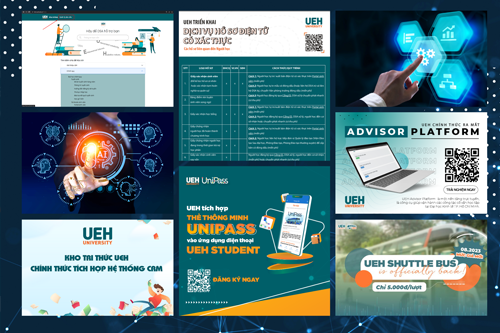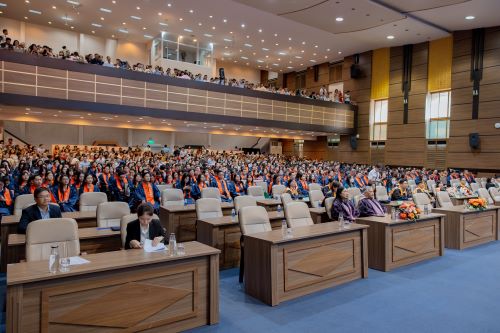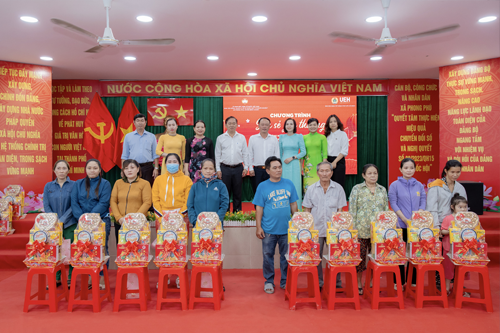![[Podcast] Upon Artificial Intelligence (AI) Improving Store Layout Design: An Overview Study](/images/upload/img_background/ueh-bg-104011-010224.png)
[Podcast] Upon Artificial Intelligence (AI) Improving Store Layout Design: An Overview Study
The importance of store layout in influencing consumer behavior is well established. Other studies consistently indicate a positive correlation between optimized layouts and increased sales. Recognizing the impact of Artificial Intelligence (AI) in enhancing traditional store layout strategies, the authors from University of Economics Ho Chi Minh City (UEH) and foreign collaborators conducted this study which comprehensively evaluates both conventional store layout design methods and modern AI techniques. By merging the insights from these two fields, the goal is to propose an improved store layout design framework powered by AI.

The importance of AI application in store layout design
The retail community has been leveraging the power of Artificial Intelligence (AI) for many specialized tasks related to purchase transactions, listed as in-person checkout, free grocery checkout by Amazon Go, image and voice search by Walmart, Tesco, Kohl’s, Costco and track customer satisfaction and predict customer behavior. In 2019, the retail sector led in global spending on AI systems, with $5.9 billion invested in automated customer service, shopping advisors and product recommendation platforms.
However, the research on AI application in supporting store layout has not been totally paid much attention. How to apply AI in understanding customer movement behavior in supermarkets is for providing appropriate design recommendations for each type of supermarket besides the items that need to be emphasized more. This study conducts a comprehensive assessment of current supermarket and store layout methods; in addition, modern AI techniques that can be used to understand customer movements when shopping in supermarkets help identify emotions so as to suggest the most suitable layout.
In accordance with this review, an AI-powered store layout design framework is proposed. The research results suggest one framework that applies advanced AI and data analytics techniques on the existing CCTV systems and video surveillance infrastructure in order to understand, to predict and to recommend better store layouts. This recommended framework facilitates the design of customer-oriented store layouts by visually monitoring data of customers moving within a supermarket or store, leading the increase in customer insights and business intelligence applications.
Store layout aiming to provide four factors: Perceived usefulness, Ease of use, Entertainment and Time consumption.
There are 4 main ways to design store layout as follows:
*Optimizing customer access to many products helps stimulate shopping decisions. Retailers strategically position the needed products at the end of aisles to optimize visibility and utility, increasing the likelihood of customers who become interested in other products (Tan et al., 2018). The effective use of end-aisle areas, especially during special occasions listed as holidays, attracts additional customer volume and encourages the exploration of various products (Page et al., 2019). Customers are forced to navigate the entire aisle, creating opportunities to display and to sell other products along the way. Designing the sales floor layout as a sales magnet ensures customers to pass through different sections, creating significant opportunities for interaction with various products (Ohta & Higuchi, 2013).
*Increasing viewing time: The goods are arranged in different cluster configurations for short, medium and long trips (Larson et al., 2005). More or less time spent at the supermarket can indicate whether customers are interested in shopping at the supermarket (Kim & Kim, 2008; Sorensen, 2016). Shopping can be a way to reduce stress and to enjoy free time (Guiry et al., 2006; Hart et al., 2007). By planning the store layout, the fact that the retailers encourage customers to move through more aisles and view a variety of merchandise can increase sales (Cil, 2012), even leading to the uncontrolled purchases (Geetha et al., 2013).
It is easy to find the related products to increase customer satisfaction. A store layout organized by product groups for shopping purposes can enhance sales (Hansen et al., 2010). Therefore, stores can arrange alternative and complementary products in the same area. For example, tea and coffee are substitute products. Grouping products this way replaces customers searching for tea in the beverages area, cheese in the cottage cheese area, and cereals in the cereal area. This layout leads customers along specific paths to visit as many parts of the store as possible (Kim & Kim, 2008; Vrechopoulos et al., 2004). Additionally, industrial store layouts often arrange related products together, listed as in the bakery section (with bread, cakes, cookies, and other products) and the vegetable section (with carrots, beans, and other products). Furthermore, exposing consumers to professionally-presented goods in those areas can lead to higher sales (Kiran et al., 2012).
* It is easy to find related products to increase customer satisfaction. A store layout organized by product groups for shopping purposes can enhance sales (Hansen et al., 2010). Therefore, stores can arrange alternative and complementary products in the same area. For example, tea and coffee are substitute products. Grouping products this way replaces customers searching for tea in the beverages area, cheese in the cottage cheese area, and cereals in the cereal area. This layout leads customers along specific paths to visit as many parts of the store as possible (Kim and Kim, 2008; Vrechopoulos et al., 2004). Furthermore, exposing consumers to professionally presented goods in such areas can lead to higher sales (Kiran et al., 2012).
*Cost control and inventory calculations: Setting up the right layout and using artificial intelligence to track images and people flow allows retailers to control costs, calculate inventory on time and replenishing products on shelves (Yang and Chen, 1999). Frontoni et al. proved that machine learning can predict the available display space in a store and recognize shortages of goods on shelves to the center (Frontoni et al., 2017). Employees receive notifications and quickly replenish products so as not to miss any customers.
Proposing a plan to use AI in designing the store layout
Using AI can help design store layouts in accordance with the following goals:
Detecting customers and shopping carts:
-
Heatmap analysis can detect people to build business temperature maps. A heatmap can provide one visual summary of information through a two-dimensional representation of the data. There are many ways to display heatmaps; however, they all share one thing in common: they use colors to draw the relationships among all data values that would be more difficult to understand if presented as a table of numeric values.
Customer identification:
-
Facial recognition is one of the most natural human characteristics for determining identity due to the way we recognize people. Facial recognition relies on the biological science of detecting and measuring various features, or features, of the human face to determine identity. When a new face appears in the scene, the program compares with a collection of faces, previously collected, to infer the identity of the new face.
-
Customer Characterization not only extracts information regarding identity but also contains important demographic attributes, including a person’s age, gender and ethnicity. Age, gender and ethnicity of both customers are extracted from facial images. In a supermarket environment, this information can be used in a variety of ways to customize targeting for each customer.
Customer behavior tracking
-
Human tracking in a camera generates human subjects’ motion trajectories over time by determining their position in each frame of a given video sequence. Based on the correlation between human subjects, human tracking in a camera can be classified into two types: generative tracking and discriminative tracking.
Emotion recognition
Humans express emotions through observable facial expressions listed as raising eyebrows, opening eyes, or changing mouth expressions (e.g., smiling). Understanding how customers feel as they browse a store can provide marketers and managers with a valuable tool for understanding customer reactions to the products they sell.
-
Multimedia emotion recognition: People also express emotions in many different ways listed as raising their voice and pointing with their fingers. This program is used to capture contextual information in data. Deep Belief Networks can also be used to further capture cross-modal interactions. Context information can be captured and modeled to improve accuracy.
-
Customer action identification: How customers behave or act reveals their interest in the product. Some obvious actions like picking up a product, placing it in the cart, and putting it back on the shelf have attracted great interest from smart stores. Other behaviors like staring at a product and reading the product box are a goldmine for marketing to understand customer interest in the product. From a marketing perspective, these behaviors provide further evidences in studying the elements of the shopping decision-making process that determine specific consumer choices and how marketing strategies can influence consumers. The empirical studies of consumer behavior are mainly dependent upon the cognitive methods, which allow to predict and to identify actions that can result in conclusions and suggest consequences for communication and marketing strategies .
Consequently, Artificial Intelligence (AI) technology can be applied to improve layout design as follows:
-
The data layer at the “Sense” stage includes data streams from CCTV cameras and recorded videos, metadata data, customer data, market layout data, etc. In addition to dynamic information sources (data in circulation), there can be static information sources listed as floor data. Collections at this data layer collect continuously or on demand at certain intervals and create a resource pool.
-
The intelligent video analysis layer at the “Think” stage plays an important role in understanding the content of images and videos. Intelligent video analytics includes a variety of artificial intelligence, computer vision, machine learning and deep learning techniques to detect, to recognize, to track, to analyze and to extract meaningful information from images and videos .
-
The implementation layer in the “Act” phase uses the analysis results and insights from the analysis layer to take actions listed as improving the layout, measuring the success of the improved layout, evaluating the results obtained and continuously adjusting the created layout. Two examples of using the STAL framework could be the studying maps of customer density or time spent in stores (Ferracuti et al. 2019) to create optimal layouts. Layout variables that management might consider include store design variables (e.g., spatial design, point-of-sale displays, product placement, cashier placement), staffing (e.g., quantity, location), and customers (e.g., crowding, visit time, unexpected shopping, furniture usage, waiting in line, product display acumen).
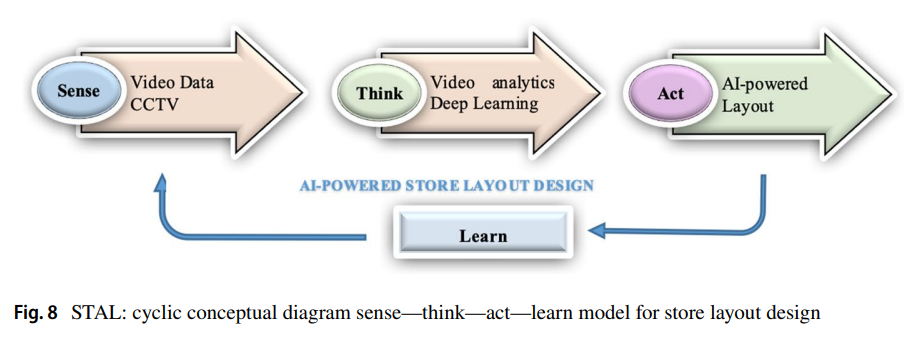
Figure 1 – Model of Sense – Think – Act
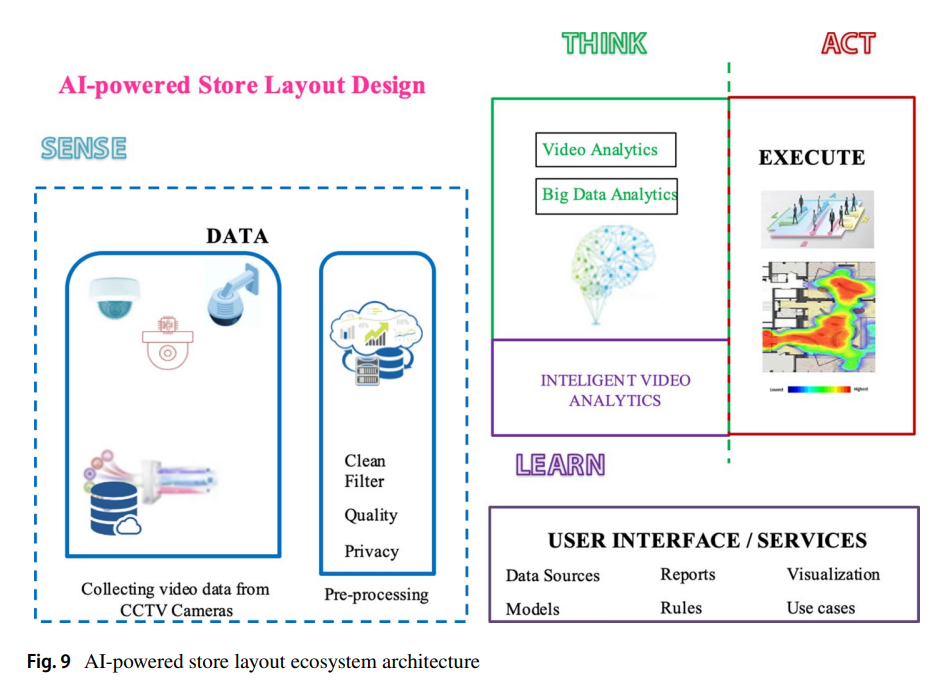
Figure 2 – Model of Sense – Think – Act applying AI
This research focuses on improving supermarket layout design to enhance customer satisfaction and to increase sales. It evaluates the existing methods in the task of layout design, research on Artificial Intelligence (AI) techniques and big data that can be applied in this problem. In particular, the study proposes a comprehensive framework for applying AI techniques on the existing surveillance cameras to understand customers and their in-store behavior. The research results suggest how to design appropriate stores and to change marketing strategies in accordance with the information from data analysis of videos.
Please refer to the full article Upon Artificial Intelligence (AI) Improving Store Layout Design: An Overview Study TẠI ĐÂY.
Author: Dr. Lê Thị Hồng Minh et al. - Faculty of Marketing - International Business, University of Economics Ho Chi Minh City (UEH).
This is an article in the series of articles spreading research and applied knowledge from UEH with the “Research Contribution For All – Nghiên Cứu Vì Cộng Đồng” message, UEH cordially invites dear readers to look forward to the upcoming Knowledge Newsletter ECONOMY No. #104.
News & photos: Author, UEH Department of Marketing & Communication
Voice of: Ngọc Quí


